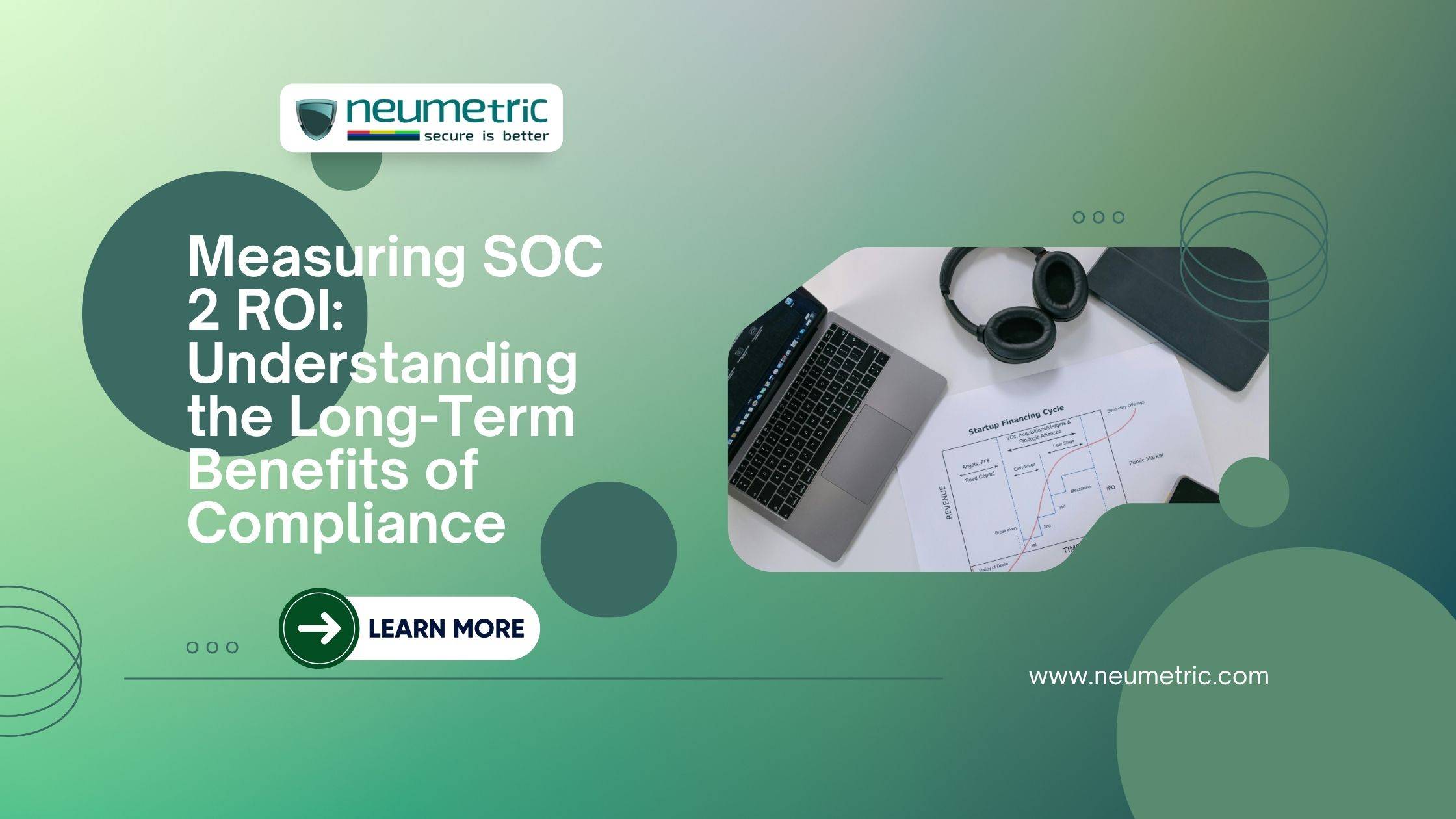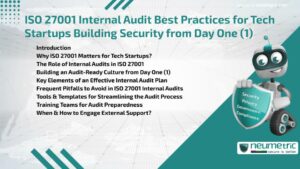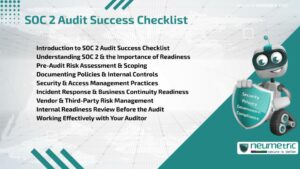Table of Contents
ToggleIntroduction
SOC 2 compliance is a lighthouse for businesses looking to protect sensitive data in a time when data security is critical. SOC 2, which was created by the American Institute of Certified Public Accountants [AICPA], emphasises concepts like security, availability, processing integrity, confidentiality & privacy when defining requirements for handling & safeguarding consumer data. For businesses handling sensitive data, compliance with SOC 2 is essential since it demonstrates a dedication to strong information security procedures.
Knowing Return on Investment [ROI] is critical for organisations investing in cybersecurity measures enhancement. In the context of information security, ROI goes beyond financial gains; it encompasses the long-term value derived from securing data, building trust & mitigating risks. Organisations can evaluate the observable & non-observable advantages that lead to long-term success by measuring the Return on Investment [ROI] of projects such as SOC 2 ROI.
The Initial Investment: Understanding Costs & Resources
Financial & human resources must be allocated strategically in order to begin the SOC 2 compliance journey. The first investments include putting in place security measures, a dedicated compliance staff & policies & processes that are documented in accordance with SOC 2 standards.
The expenses related to SOC 2 compliance go beyond financial implications & include the use of time, technology & human resources. The whole cost includes the use of security technologies, personnel training & third-party evaluations.
While the initial investment in SOC 2 compliance may seem substantial, organizations must perceive it as a strategic commitment with long-term dividends. Balancing short-term costs against the anticipated long-term gains involves recognizing the value of enhanced security, customer trust & regulatory adherence, ultimately positioning the organization for sustained success.
Building Trust: Enhancing Reputation & Customer Confidence
SOC 2’s Function in Establishing Trust: Any successful company relationship is built on trust & SOC 2 compliance is essential to fostering this trust. By following the strict security, availability & confidentiality guidelines provided in SOC 2, companies demonstrate to their stakeholders & clients that protecting sensitive data is of utmost importance. For those who entrust their data to the organisation, the framework acts as a concrete commitment to strong information security practises.
Effect on Customer Credibility & Trust: SOC 2 compliance has a significant effect on customer confidence. Clients are becoming more picky about the security procedures used by their service providers, particularly in sectors where data protection is critical. SOC 2 compliance offers reassurance that the company has passed strict evaluations & complied with requirements for protecting sensitive data. This, in turn, raises the organization’s perceived credibility & creates a safe & encouraging business environment.
Customer Acquisition & Retention: A Competitive Edge
Gaining New Business through SOC 2 Compliance: Businesses that are SOC 2 compliant have a clear edge in luring in new customers in a cutthroat market. SOC 2 compliance becomes a difference that helps organisations stand out as data security becomes an increasingly important priority for enterprises. SOC 2 is seen by potential customers as an indication of the company’s dedication to data security, which inspires trust & makes the business an appealing option for people looking for dependable & safe services.
Retaining Existing Customers Through Enhanced Security Measures: Beyond attracting new clients, SOC 2 compliance plays a crucial role in retaining existing customers. Clients are more likely to stay loyal to a service provider that demonstrates a proactive approach to information security. The assurance of SOC 2 compliance provides existing customers with confidence that their data is in secure hands, reducing the likelihood of churn & contributing to long-term, mutually beneficial relationships.
Analyzing the Competitive Edge Gained in the Market: The competitive edge gained through SOC 2 compliance extends beyond customer acquisition & retention. Organizations that prioritize information security create a positive narrative in the market, positioning themselves as leaders in data protection. This enhanced reputation not only attracts clients but also opens doors to strategic partnerships, collaborations & opportunities that may be reserved for entities with a proven commitment to robust information security practices.
Regulatory Adherence: Avoiding Penalties & Legal Consequences
Regulatory Compliance’s Significance Exceeds ROI: Adherence to regulations is not just a box to be checked; it is an essential component of ethical business practises. Regulatory compliance, particularly when it comes to data security as stressed by SOC 2, guarantees that organisations are in line with industry norms & legal frameworks, which goes beyond the measurable Return on Investment [ROI]. Adhering to moral business conduct is known as compliance & its benefits go beyond monetary rewards to include building a reliable, law-abiding company reputation.
Potential Legal Consequences of Non-Compliance: The repercussions of non-compliance with regulatory standards, such as those outlined in SOC 2, can be severe. Legal consequences may include fines, sanctions & legal actions that not only dent the organization’s finances but also tarnish its reputation. Non-compliance can lead to breaches of customer trust, damage to brand integrity & strained relationships with regulatory bodies, amplifying the long-term impact on the organization’s standing in the industry.
Operational Efficiency: Streamlining Processes for Long-Term Success
Improvements in Internal Processes Post-SOC 2 Compliance: SOC 2 compliance is not solely about meeting regulatory requirements; it catalyzes improvements in internal processes. The process of aligning with SOC 2 principles necessitates a meticulous review & enhancement of operational workflows. Post-compliance, organizations often find that their internal processes are not only more secure but also more efficient, leading to streamlined operations.
Streamlining Operations Through Standardized Security Measures: Standardized security measures, as mandated by SOC 2, become ingrained in the fabric of day-to-day operations. These measures not only enhance security but also contribute to operational efficiency. With standardized processes, employees spend less time navigating complex security protocols, enabling them to focus on core responsibilities. This streamlined efficiency results in operational cost savings & improved overall productivity.
Risk Mitigation: Protecting Against Future Threats
The Benefits of Risk Mitigation in the Long Run: Over time, risk reduction is a proactive approach that yields significant benefits. Meeting current requirements is only one aspect of SOC 2 compliance; another is a continuous commitment to risk identification & mitigation. The organization’s capacity to manage a constantly changing danger landscape, foresee new threats & put preventative measures in place to safeguard sensitive data is what will ultimately determine its long-term value.
SOC 2 as a Proactive Strategy for Threat Prevention: SOC 2, with its emphasis on continuous monitoring & risk assessment, positions organizations as proactive agents in the realm of information security. By identifying vulnerabilities before they can be exploited, organizations mitigate the potential damage of security breaches. This proactive stance not only safeguards data but also shields the organization from the reputational & financial fallout associated with reactive approaches to security.
Demonstrating Value to Stakeholders: Communicating SOC 2 ROI Effectively
The process of determining metrics that encompass both quantitative & qualitative elements is necessary to calculate the Return on Investment [ROI] of SOC 2 compliance. A few examples of quantitative measurements are financial savings, reduced fines & higher revenue as a result of better client acquisition. Improved consumer trust, reputation & the capacity to access new markets as a result of compliance are examples of qualitative metrics. When taken as a whole, these metrics paint a complete picture of the material & immaterial advantages gained from adhering to SOC 2.
Stakeholder support & awareness of SOC 2 compliance must be gained through effective communication of its benefits. This entails putting complicated technical terms into understandable terms & highlighting the benefits for company operations, risk mitigation & general resilience. Executives, investors & clients are among the stakeholders who should be made aware of how SOC 2 compliance improves security, advances organisational objectives & establishes the company as a reliable player in the industry.
Case studies & examples serve as powerful tools to illustrate the effectiveness of communication strategies in conveying the value of SOC 2 compliance. Success stories of organizations that have effectively communicated the ROI of compliance, demonstrating concrete improvements in security, client relationships & financial outcomes, provide tangible evidence of the benefits. These examples serve as inspiration for other organizations seeking to articulate the value of their own compliance efforts.
Continuous Improvement: Adapting to Evolving Threats & Technologies
SOC 2 compliance is a constant commitment to improvement rather than a one-time accomplishment. Regular risk assessments, audits & adaptation to emerging threats are mandated under the framework. By taking a proactive stance, organisations may stay adaptable to changing regulations, technological breakthroughs & cyber threats. The SOC 2 concept is deeply rooted in continuous improvement, which cultivates a culture of adaptation & resilience.
Organisations must keep up with the ever-changing landscapes of technology & legislation in order to comply with SOC 2. SOC 2 acts as a compass for navigating the always shifting landscape of information security, whether it is through the adoption of new encryption technologies, the updating of access restrictions, or the alignment with the most recent legal standards.
The proactive nature of SOC 2 compliance positions organizations to stay ahead of emerging threats. By conducting regular risk assessments, monitoring industry trends &incorporating the latest cybersecurity measures, organizations create a robust defense against potential vulnerabilities. Staying ahead of emerging threats not only protects sensitive information but also contributes to the organization’s overall resilience & ability to maintain a competitive edge in a rapidly evolving digital landscape.
Conclusion
Looking back, SOC 2 compliance provides a plethora of enduring advantages beyond the original financial outlay. SOC 2 compliance has long-lasting benefits that range from fostering reputation & trust to guaranteeing regulatory compliance, operational effectiveness & proactive risk management. Every component helps the company maintain resilience, stability &long-term success in an increasingly complicated digital world.
It is recommended that organisations see SOC 2 compliance as a strategic investment in their future, rather than just a legal requirement. The framework is the cornerstone of a resilient business strategy because it may strengthen information security, foster trust &position organisations for long-term success.
In a world where data is a valuable asset & security breaches can have profound consequences, maintaining information security standards, exemplified by SOC 2 compliance, is an enduring imperative. It is not only a reflection of an organization’s commitment to protecting sensitive information but also a strategic move that pays dividends in reputation, client relationships & overall business resilience. As technologies & threats evolve, organizations that prioritize continuous improvement & adaptability through SOC 2 compliance are better equipped to navigate the challenges of the digital landscape & thrive in the long run.
FAQ’s
- How can I measure the Return on Investment [ROI] of SOC 2 compliance for my organization?
Measuring the ROI of SOC 2 compliance involves quantifying financial gains, such as cost savings and increased revenue, as well as assessing qualitative benefits, including enhanced reputation, customer trust, and operational efficiency, providing a comprehensive view of the value derived from the investment.
- What are the long-term benefits that my organization can expect from SOC 2 compliance?
Beyond immediate gains, SOC 2 compliance offers enduring benefits like enhanced reputation, customer trust, operational efficiency, and proactive risk mitigation.
- Is SOC 2 compliance only about avoiding penalties, or does it offer broader advantages?
While avoiding penalties is a part of it, SOC 2 compliance goes beyond. It establishes a positive work environment, fosters a culture of efficiency, and positions the organization as a leader in information security.





